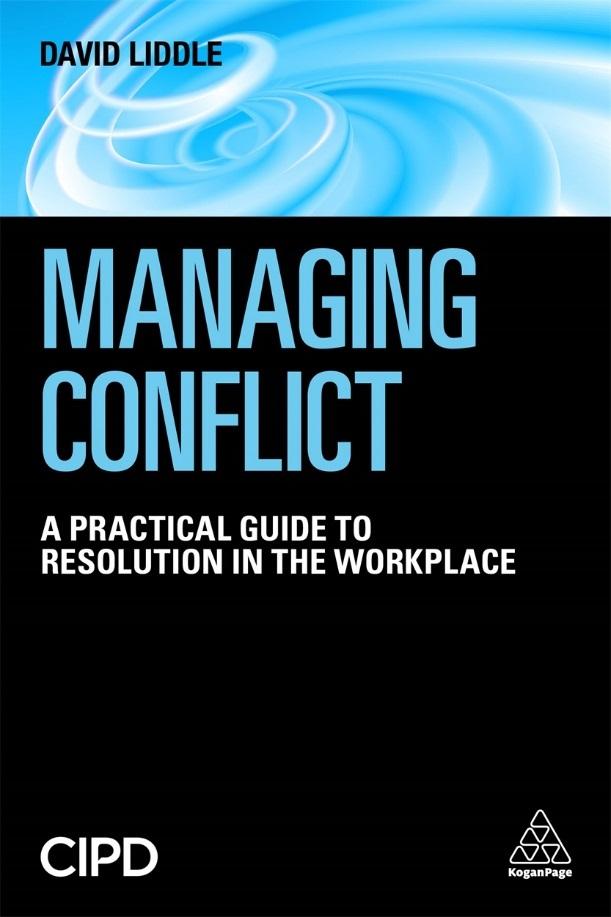Managing Conflict Summary
6 min read ⌚
 A Practical Guide to Resolution in the Workplace
A Practical Guide to Resolution in the Workplace
Managing employees is a difficult job.
And sometimes even having a justified reason to dismiss an employee may not be enough since it’s still unfair if you don’t use the correct procedures.
The best way to avoid all that – preventive mediation.
David Liddle explains the benefits of this and many other similar strategies in his indispensable conflict resolution guide, “Managing Conflict.”
Who Should Read “Managing Conflict”? And Why?
As its title suggests, “Managing Conflict” is a must-read for HR officers and other executives who have similar jobs, whether it is managing people or establishing conflict resolution practices.
However, many other people can benefit from it, since, as they say, half of the solution to a problem is understanding it – and “Managing Conflict” offers a great shortcut to understanding why we tend to have so many unnecessary conflicts and what is the best way to transcend them.
 About David Liddle
About David Liddle
David Liddle is one of the leading conflict mediators in the United Kingdom, with a twenty-year-long experience in the field.
In 1994, he established one of the first community mediation schemes in the UK, Leicestershire Mediation Service, a scheme he ran for the next eight years when he established CRISP, the Conflict Resolution in Schools Programme.
In 2001, David established the Total Conflict Management Group (TCM group), which has, ever since, been the UK’s leading consulting company for mediation, conflict management, and leadership development.
See more at www.thetcmgroup.com.
“Managing Conflict PDF Summary”
According to the Centre for Effective Dispute Resolution (CEDR) companies in the United Kingdom spend over $44.5 billion annually to battle conflict costs.
Now, that’s a lot!
And that doesn’t even include all the immaterial damages – like, for example, reputation – which can theoretically hurt a company much more in the long run.
The simple premise of David Liddle’s book “Managing Conflict” is that this all can be avoided – or, at least, substantially alleviated – if companies put a little more emphasis on conflict management.
Unfortunately, they almost never do that.
So, they spend their pounds on cures, even though an ounce of prevention (a specific kind for a specific stage) may be all that they need:
The simplest, quickest and most effective way to prevent a harmful and costly conflict from escalating is to have a direct conversation with the other person as early as possible.
Now, most leaders are uncomfortable talking conflicts, and their idea of arbitration is basically just turning to any one of the conventional grievance strategies.
However, as most employees who have filed formal complaints have learned by now, they usually don’t work.
Most because they are outdated and are based in a dynamic of power which doesn’t lead to a resolution satisfactory for both sides, but to a temporary hushing and implicit assertiveness of control by the employer, which actually deepens the initial problem with the employee.
Some of the grievance strategies – such as early resolution, facilitated roundtable conversations, or resolution triage assessments – are actually okay, but companies don’t use them properly.
Mediation has always been – and still remains – the best strategy for tackling conflicts.
It’s integrative and just, as it allows both parties to tell their side of their story while giving the power to a more objective and neutral third side to assist them to settle their disagreements.
The best part of a mediation is the fact that it transforms conflicts into a breeding ground for progress, converting the dysfunctions of a team into a set of learning lessons for both managers and employees.
As Steven Covey demonstrated in his testamentary book, the third alternative shouldn’t be just an HR practice – it can be a way of life!
Job contracts don’t take into consideration the unpredictable work environment and the emotions, desires, beliefs, and motivation of an individual worker.
Conflicts stem from these incongruities.
Consequently, the resolution must try to overcome them, and the only way it can do that is by moving from generalizations to particularity, from the way companies work to the actual way individual people behave in the workplace and outside it.
Simply put, conflicts do not arise out of people reasoning properly; most conflicts are the result of wrong assumptions, which, by definition, makes them a grey area, where there is hardly ever a right or wrong side, but where there’s always some kind of a profound misunderstanding.
In fact, David Liddle says that:
In over 90% of the cases that I mediate, the parties realize that their perceptions, while valid, were incorrect; they had wrongly assumed malintent by the other.
And that’s what mediators usually do: they encourage the discussion until it reaches the point where both employees and employers understand that there’s another side to the same story and that it is wrong to attribute to malice that which can be adequately explained by some other cause; and this cause can be anything from fear and prejudice to lack of information and even incompetence.
Institutionalizing mediation may be the best thing a company can do since this act shows the employees dedication to conflict resolution which makes them feel a lot safer and more comfortable in their job positions.
Key Lessons from “Managing Conflict”
1. The Six F’s of Management Theory
2. The Five Stages of a Conflict’s Life Cycle
3. Implement a Great Meditation Program in 10 Steps
The Six F’s of Management Theory
Curiously, most of management theory is built around the six F’s: fights, feelings, fear, failure, forgiveness, and flow.
If you want a functional company, you must learn to manage fights productively, which basically means understanding your employees’ feelings and fears.
It also means creating an environment, where their worst fears will be annulled, or, in other words, a place where failures are met with forgiveness and considered stepping stones to success.
All of this inspires a flow both in terms of work processes and dialogue, which are the prerequisites of a successful company.
The Five Stages of a Conflict’s Life Cycle
Almost every conflict in a company follows a similar pattern which involves five stages: pre-conflict, early conflict, mid-conflict, late conflict, and post-conflict.
Now, all of these stages ask for different approaches and, moreover, different strategies for resolution.
So, the most important thing when mediating a conflict is to first identify the stage in which it is.
Only then, you should move to finding an appropriate resolution, based on a pre-prepared strategy.
Implement a Great Meditation Program in 10 Steps
If you want to implement a meditation program in your company, try to follow these steps.
First – obviously – pick an expert; then, gather data and prepare the field for the introduction of mediation.
It’s necessary to build the program in close association with management, HR, and even unions. Only then you can develop a program which will suit everybody and move on to building a team of internal/external mediators.
Once you do that – it’s only obvious that you’ll need to select a mediation coordinator and train all parties in the use of mediation practices and tools.
Ensuring that everyone is up-to-date and spreading awareness of mediation within the organization shouldn’t be just marginal tasks.
Finally, monitor the impact of mediation and see where – and even if – you can improve.
Like this summary? We’d like to invite you to download our free 12 min app, for more amazing summaries and audiobooks.
“Managing Conflict Quotes”
The world is less certain than it was, and our organizations are microcosms of this uncertain world. Conflict is at the heart of that uncertainty: both a cause and a symptom. Share on X
Due to a lack of an intervention to address the issues at source, situations quickly escalate into a more serious conflict. Share on X
Conflict is not logical; it is irrational. Conflict is not black and white; it is grey. Share on X
Some managers’ lack of empathy, compassion, flexibility and self-awareness can come across as rudeness, hostility, abuse, prejudice and intimidation… classic signs of ‘bullying.’ Share on X
The only way to address conflict is to find a shared meaning, a shared solution and a way forward – together. Share on X
Our Critical Review
“Managing Conflicts” primarily deals with UK firms – after all, David Liddle is British – so there may be some case studies (from legal and similar perspectives) which are limited to his home country.
However, most of the book is, fortunately, not – and works a great manual, which includes tips, tricks, tools, charts, exercises – an even links to additional online materials.
Emir is the Head of Marketing at 12min. In his spare time, he loves to meditate and play soccer.


 A Practical Guide to Resolution in the Workplace
A Practical Guide to Resolution in the Workplace  About David Liddle
About David Liddle




